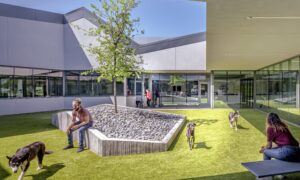Look Up: A Conversation on Design, Delight, and Experience
August 26, 2025
Last week, Dreyfuss + Blackford gathered for our first Look Up event, a new series that steps back from day-to-day and explores broader ideas shaping design. Hosted in our Sacramento office, the discussion centered on how design is experienced—both in the moment and across time—and the way intent, delight, and design principles shape meaningful spaces.
We began with a short video that sparked conversation. In the film, an artist described their studio by saying: “If you could take a picture inside my brain, this place is probably what it would look like.” That sentiment resonated with our team.
Reflecting on the idea, Jen Reid, Interior Design Director, offered:
“We can ask something similar of our clients: What does the inside of your organization’s brain look like? What values do you want to project? When design translates those ideas into space, users can walk in and instantly understand who you are—through the experience itself.”
This framing reminds us that great design is not just about form or function, but about communicating identity. Buildings have the power to embody the mission, vision, and culture of an organization in ways that words alone cannot. Maintaining that clarity requires a consistent through-line—design intent—that guides every decision, from the overarching concept to the smallest detail.
The conversation then shifted toward the importance of carrying design intent through every detail. Erin Richardson, Principal Art Consultant with Creative Art Concepts, reflected on how the American Craftsman tradition exemplifies this idea. In Craftsman homes, artisans across trades—woodworkers, metalworkers, glass artists—worked together toward a unified vision. No single detail stood alone; everything was part of a larger whole.
Building on Erin’s insight, Sam Lang, Project Designer, observed:
“A building is never experienced all at once, but in moments. It’s through this consistent carry-through of design intent, individual moments can present and participate in the unity of the whole.”
Seeing Delight in Built Spaces
At Chapa-De Indian Health’s South Placer Clinic, design began with deep engagement with the client. By exploring the mission, vision, and values, the team gained insight into what the space needed to communicate—not just functionally, but emotionally and culturally. The building was carved into the landscape, creating moments of connection with nature that support healing and reflection. Courtyards, gardens, and daylighting allow patients and staff to pause, engage with the space, with nature, and experience the client’s ethos at every turn.
At the County of Santa Clara Animal Services Center, the design centers around a park-like courtyard that serves as the heart of the facility. By understanding what promotes the health and well-being of animals, as well as creating an environment that supports adoption, the design organizes circulation and program around this central space. Visitors experience the building through this park, with light-filled pathways, accessible outdoor runs, and thoughtfully composed areas for interaction, creating moments of warmth, connection, and delight for both animals and people.
These examples illustrate how a commitment to design intent can shape how a building is experienced—not as a single, complete object, but as a sequence of moments that, together, form a cohesive project.
Looking Ahead
The Look Up series is meant to do just that: to look beyond deadlines and deliverables and instead reflect on the ideas that drive our practice forward. At its core, design is a dialogue—between architects, collaborators, and clients—but it’s also about the impact of the spaces we create: how they shape experience, inspire delight, and communicate the mission and values of the people and organizations they serve.
We look forward to continuing these conversations, sharing insights, and learning from colleagues across the design industry. Thoughtful design has the power to create meaningful experiences—moment by moment—for every user of a space, and this dialogue helps us discover new ways to bring that to life.



